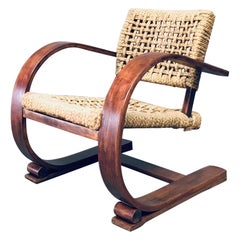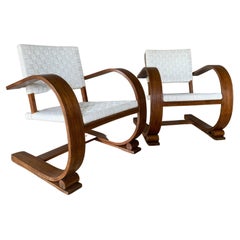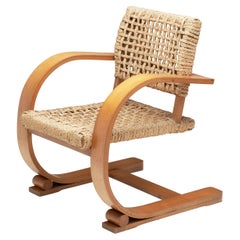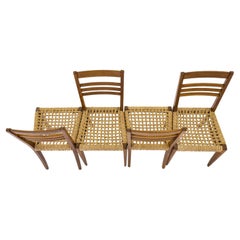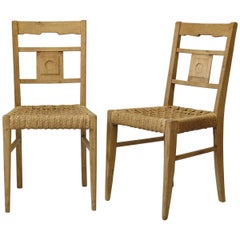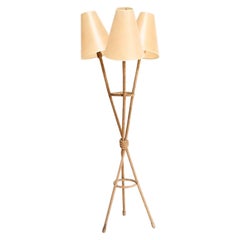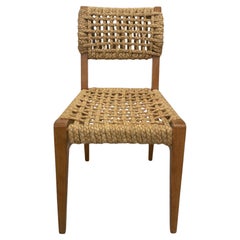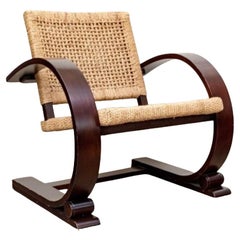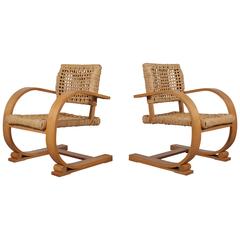Audoux Minet Vesoul
Vintage 1950s French Mid-Century Modern Armchairs
Rope, Beech
Vintage 1930s French Bauhaus Lounge Chairs
Rope, Wood
Vintage 1950s French Mid-Century Modern Lounge Chairs
Ash
Mid-20th Century French Mid-Century Modern Armchairs
Rope, Bentwood
Vintage 1950s French Mid-Century Modern Armchairs
Rope, Wood
Mid-20th Century French Mid-Century Modern Dining Room Chairs
Rope, Oak
Mid-20th Century French Mid-Century Modern Dining Room Chairs
Rope, Oak
Vintage 1950s French Floor Lamps
Fabric, Rope
Vintage 1950s French Mid-Century Modern Armchairs
Straw, Beech
Mid-20th Century Chairs
Beech
20th Century Unknown Mid-Century Modern Armchairs
Cane, Wood
Recent Sales
Mid-20th Century French Mid-Century Modern Dining Room Chairs
Raffia, Oak
Vintage 1950s French Mid-Century Modern Armchairs
Beech, Rope
Vintage 1950s French Mid-Century Modern Armchairs
Beech, Rope
Vintage 1950s Chairs
Rope, Wood
20th Century French Mid-Century Modern Lounge Chairs
Rope, Ash
Vintage 1950s French Mid-Century Modern Armchairs
Seagrass, Rope, Wood
Vintage 1950s French Armchairs
Rope, Bentwood
Vintage 1940s French Modern Coffee and Cocktail Tables
Seagrass, Wood
Vintage 1940s French Organic Modern Armchairs
Bentwood, Seagrass
Mid-20th Century French Mid-Century Modern Armchairs
Rope, Beech
Vintage 1940s French Modern Coffee and Cocktail Tables
Seagrass, Wood
Vintage 1940s French Modern Armchairs
Seagrass, Rope, Bentwood
Vintage 1950s French Mid-Century Modern Armchairs
Rope, Oak
Mid-20th Century French Armchairs
Rope, Oak
Vintage 1940s French Modern Armchairs
Seagrass, Rope, Bentwood
Vintage 1950s French Mid-Century Modern Chairs
Rope, Wood
Vintage 1960s French Mid-Century Modern Armchairs
Rope, Wood
Mid-20th Century French Mid-Century Modern Lounge Chairs
Rope, Wood
Vintage 1940s French Mid-Century Modern Armchairs
Rope, Bentwood
Mid-20th Century French Mid-Century Modern Lounge Chairs
Rope, Beech
Vintage 1940s French Arts and Crafts Armchairs
Rope, Wood
Mid-20th Century French Mid-Century Modern Lounge Chairs
Rope, Wood
Mid-20th Century French Mid-Century Modern Stools
Mid-20th Century French Mid-Century Modern Lounge Chairs
Rope, Wood
20th Century American Chairs
Cane, Wood
Vintage 1950s French Mid-Century Modern Armchairs
Rope, Oak
Mid-20th Century French Mid-Century Modern Armchairs
Rope, Beech, Bentwood
Vintage 1950s French Mid-Century Modern Lounge Chairs
Rope, Wood
Vintage 1960s French Mid-Century Modern Armchairs
Rope
Vintage 1930s Mid-Century Modern Lounge Chairs
Seagrass, Rope, Wood
Mid-20th Century French Arts and Crafts Armchairs
Rope, Wood
Vintage 1940s French Modern Armchairs
Seagrass, Rope, Bentwood
Vintage 1940s French Modern Armchairs
Seagrass, Rope, Bentwood
Vintage 1940s French Modern Console Tables
Seagrass, Rope, Oak
Mid-20th Century French Mid-Century Modern Dining Room Chairs
Rope, Beech
Mid-20th Century French Mid-Century Modern Stools
Vintage 1940s French Armchairs
Vintage 1950s French Mid-Century Modern Side Chairs
Oak, Rope
21st Century and Contemporary Asian Side Chairs
People Also Browsed
21st Century and Contemporary Swedish Mid-Century Modern Table Lamps
Textile
2010s South African Minimalist Pedestals
Wood
2010s Danish Scandinavian Modern Dining Room Chairs
Oak
2010s British Mid-Century Modern Daybeds
Bouclé, Oak
2010s Table Lamps
Iron
2010s American Mid-Century Modern Wall Lights and Sconces
Brass, Bronze, Enamel, Nickel
21st Century and Contemporary American Chandeliers and Pendants
Brass
Vintage 1950s German Mid-Century Modern Stools
Metal
2010s Danish Scandinavian Modern Dining Room Chairs
Oak
2010s South African Minimalist Pedestals
Wood, Poplar, Burl
21st Century and Contemporary Danish Mid-Century Modern Wall Mirrors
Brass
21st Century and Contemporary Swedish Scandinavian Modern Wall Lights an...
Metal
21st Century and Contemporary Swedish Scandinavian Modern Wall Lights an...
Metal
2010s Mexican Brutalist Contemporary Art
Wood
21st Century and Contemporary Danish Mid-Century Modern Floor Lamps
Brass
20th Century Mid-Century Modern Lounge Chairs
Walnut, Upholstery
Audoux Minet Vesoul For Sale on 1stDibs
How Much is a Audoux Minet Vesoul?
Adrien Audoux and Frida Minnet for sale on 1stDibs
While little is known about audacious modernist designers Adrien Audoux and Frida Minet, the French-Swiss husband-and-wife duo created playful and unique decorative objects, dining chairs, sconces and other furniture during the mid-20th century. Rejecting Art Deco lavishness and the concept that seating, tables and other furnishings should be made with luxurious and exotic materials, Minet and Audoux adopted a rustic style in their work, integrating abaca hemp cord and other organic materials such as beech and bamboo in their provocative designs.
Audoux and Minet were active in Côte d'Azur, France — they are believed to have established a workshop there in the late 1920s. The designers were members of the Union des Artistes Modernes, a collective of like-minded artists founded in 1929. The raison d'être of the Union was to design household furnishings and decorative pieces for a wider demographic of people, not merely affluent Parisians — a target kind of buyer for many creators of the day. They promoted simplicity and prioritized functionalism. The collective’s membership boasted other celebrated furniture designers, including Jean Prouvé, Charlotte Perriand, Francis Jourdain and Louis Sognot.
Minet and Audoux spent much of their time in the Provence region, a hub of creativity where other artists such as Pablo Picasso found endless inspiration. They created everything from lighting to lounge chairs and end tables that reflected a nautical theme and coastal living. Minet and Audoux’s imaginative works — table lamps with shades covered in raffia, oak benches with seat backs of woven rope — were made available to passers-by in the duo’s retail outlet in the seaside resort town of Golfe-Juan. The pair also incorporated woven rope into larger pieces such as armchairs and side tables. These furnishings are often compared to the work of similarly adventurous Union des Artistes Modernes member Charlotte Perriand. Several of Audoux and Minet’s seating pieces are on display at the Maison Dumas in St. Tropez, France.
Find vintage Adrien Audoux and Frida Minet furniture on 1stDibs.
Finding the Right Seating for You
With entire areas of our homes reserved for “sitting rooms,” the value of quality antique and vintage seating cannot be overstated.
Fortunately, the design of side chairs, armchairs and other lounge furniture — since what were, quite literally, the early perches of our ancestors — has evolved considerably.
Among the earliest standard seating furniture were stools. Egyptian stools, for example, designed for one person with no seat back, were x-shaped and typically folded to be tucked away. These rudimentary chairs informed the design of Greek and Roman stools, all of which were a long way from Sori Yanagi's Butterfly stool or Alvar Aalto's Stool 60. In the 18th century and earlier, seats with backs and armrests were largely reserved for high nobility.
The seating of today is more inclusive but the style and placement of chairs can still make a statement. Antique desk chairs and armchairs designed in the style of Louis XV, which eventually included painted furniture and were often made of rare woods, feature prominently curved legs as well as Chinese themes and varied ornaments. Much like the thrones of fairy tales and the regency, elegant lounges crafted in the Louis XV style convey wealth and prestige. In the kitchen, the dining chair placed at the head of the table is typically reserved for the head of the household or a revered guest.
Of course, with luxurious vintage or antique furnishings, every chair can seem like the best seat in the house. Whether your preference is stretching out on a plush sofa, such as the Serpentine, designed by Vladimir Kagan, or cozying up in a vintage wingback chair, there is likely to be a comfy classic or contemporary gem for you on 1stDibs.
With respect to the latest obsessions in design, cane seating has been cropping up everywhere, from sleek armchairs to lounge chairs, while bouclé fabric, a staple of modern furniture design, can be seen in mid-century modern, Scandinavian modern and Hollywood Regency furniture styles.
Admirers of the sophisticated craftsmanship and dark woods frequently associated with mid-century modern seating can find timeless furnishings in our expansive collection of lounge chairs, dining chairs and other items — whether they’re vintage editions or alluring official reproductions of iconic designs from the likes of Hans Wegner or from Charles and Ray Eames. Shop our inventory of Egg chairs, designed in 1958 by Arne Jacobsen, the Florence Knoll lounge chair and more.
No matter your style, the collection of unique chairs, sofas and other seating on 1stDibs is surely worthy of a standing ovation.

